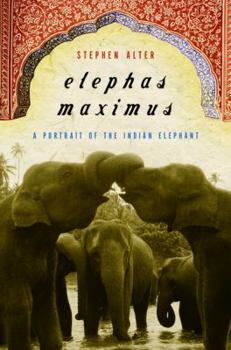Elephas Maximus: A Portrait of the Indian Elephant
Revered in Indian religion and culture, coveted for its ivory tusks, the majestic Asian elephant has captured the fascination of humans for more than four thousand years. In an effort to shed light on... This description may be from another edition of this product.
Format:Hardcover
Language:English
ISBN:0151006466
ISBN13:9780151006465
Release Date:January 2004
Publisher:Houghton Mifflin
Length:320 Pages
Weight:1.15 lbs.
Dimensions:1.2" x 5.7" x 8.6"
Related Subjects
Animals Asia Biological Sciences Biology Conservation Endangered Species Fauna India Mammals NatureCustomer Reviews
1 rating
Engaging and informative portrait of the Indian Elephant
Published by Thriftbooks.com User , 20 years ago
_Elephas maximus_ is a rather engaging- if sometimes a bit rambling - portrait of the Indian elephant (author Stephen Alter admits that the more proper common name is Asian Elephant but as he focuses on only _Elephas maximus_ as it is found in India he keeps the name Indian Elephant). Alter sought to tell the natural history of the elephant as well as its human history on the subcontinent, depicting it in history, mythology, religion, art, and literature. As he notes in the prologue, the somewhat tangential order of the chapters follows a series of journeys the author made in different parts of India in 2001-2002. Roughly chronological, each chapter details his experiences with actual elephants, those who live and work with them, and his viewings of elephant art (as well as many asides about elephants in history, legend, and literature) as he visited various national parks, shrines, museums, and festivals throughout India. I learned many interesting facts about elephant biology; the bull elephant experiences a cyclical period of sexual arousal, known as musth. Similar to the rut of a stag, musth is signaled by excretions from glands on either side of the elephant's forehead (in Indian poetry it is described as being a sweet perfume that attracted bees, though the author found it a "sour, oily" odor that attracted swarms of flies). Musth can occur any time of the year, though often afflicts elephants in June as monsoon rains begin. Elephants in musth are very temperamental and prone to fits of rage - tame elephants rarely if ever work during musth - and remain this way from a few weeks up to several months. Alter recounted the many differences between African Elephants (_Loxodonta africana_) and Indian Elephants; African Elephants tend to be taller (up to 12 feet at the shoulder versus the Indian being no larger than 10 feet), heavier (African bulls can weigh over 6 tons; Asian bulls closer to 4 tons), have larger ears, rougher hides, more wrinkled trunks, and a differently shaped skull; Africans have a more extended and tapered head while Asians have a flatter face and a more bulging forehead. The tip of the trunk on an African Elephant has two prehensile "fingers" while the Asian Elephant has but one. In Africa, both male and female elephants posses tusks; in Asia only males have tusks. Even then not all males have them; about 40 percent of all Indian bulls are tuskless and are called makhnas (in fact in some areas, such as Sri Lanka, only 10 percent of all males are tuskers, though this percentage varies a great deal locally). He discounts notions that the Indian elephant is more easily tamed, noting that simply that there is a considerably longer tradition of such training in India than anywhere else in the world. The elephant has a tremendous role in Indian religion. One example is Ganesha or Ganapati, the elephant-headed deity, bearer of joy and good fortune and son of Shiva and Parvati, who is worshipped for ten days every year





